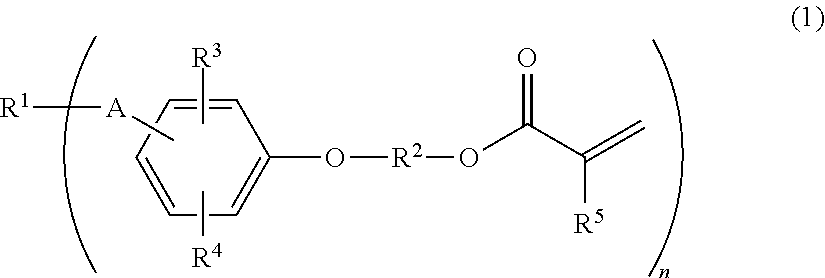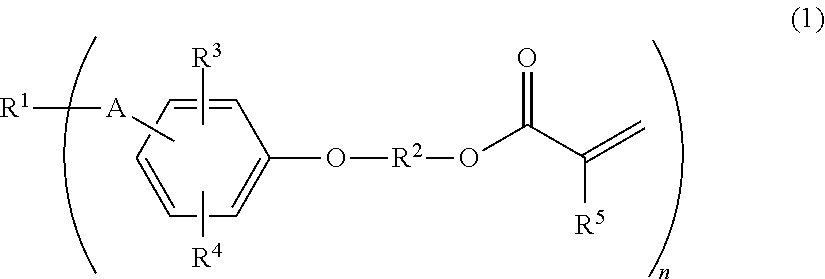(METH)acryloyl-terminated polyisobutylene polymer, method for producing the same, and active energy ray-curable composition
a technology of acryloyltermination and polyisobutylene, which is applied in the field of (meth) acryloyltermination polyisobutylene polymer, and the method for producing the same, and the active energy raycurable composition field, can solve the problems of high cost of silane compound and platinum catalyst required for synthesis, undesirable chlorine atoms in the obtained resin, and complex disclosed synthesis method. to achieve the effect of producing more simply
- Summary
- Abstract
- Description
- Claims
- Application Information
AI Technical Summary
Benefits of technology
Problems solved by technology
Method used
Image
Examples
example 1
Production of Acryloyl-Terminated Polyisobutylene Polymer (Component P-1)
[0207]A 5 L separable flask was purged with nitrogen, and then the flask was charged with 280 mL of n-hexane (which had been dried with a molecular sieve) and 2,500 mL of butyl chloride (which had been dried with a molecular sieve), and while stirring under a nitrogen atmosphere, cooled to −70° C. Next, 1,008 mL (10.7 mol) of isobutylene, 27.4 g (0.119 mol) of p-dicumyl chloride, and 1.33 g (0.014 mol) of α-picoline were added. The resultant reaction mixture was cooled to −70° C., then charged with 5.2 mL (0.047 mol) of titanium tetrachloride to start polymerization. After the polymerization started, the residual isobutylene concentration was measured by gas chromatography. When the residual amount of isobutylene fell below 0.5%, about 200 g of methanol was added. The solvent and the like was removed by evaporation from the reaction solution, and the resultant product was then dissolved in 2 L of n-hexane and w...
example 2
Production of Acryloyl-Terminated Polyisobutylene Polymer (Component P-2)
[0209]A 1 L separable flask was purged with nitrogen, and then the flask was charged with 40 mL of n-hexane (which had been dried with a molecular sieve) and 400 mL of butyl chloride (which had been dried with a molecular sieve), and while stirring under a nitrogen atmosphere, cooled to −70° C. Next, 168 mL (1.78 mol) of isobutylene, 4.57 g (0.0198 mol) of p-dicumyl chloride, and 0.222 g (0.00233 mol) of α-picoline were added. The resultant reaction mixture was cooled to −70° C., then charged with 1.0 mL (0.0091 mol) of titanium tetrachloride to start polymerization. After the polymerization started, the residual isobutylene concentration was measured by gas chromatography. When the residual amount of isobutylene fell below 0.5%, 15.2 g of 2-phenoxyethyl acrylate (manufactured by Tokyo Chemical Industry Co., Ltd.) and 22 ml of titanium tetrachloride were added. Then, after a continuous stirring for 3 hours at −...
example 3
Production of Acryloyl-Terminated Polyisobutylene Polymer (Component P-3)
[0210]To 200 ml of N,N-dimethylformamide were added 40.0 g of 6-phenoxyhexyl bromide (manufactured by Tokyo Chemical Industry Co., Ltd., 0.0778 mol), 85.7 g of potassium acrylate (manufactured by Nippon Shokubai Co., Ltd., 0.778 mol), and 0.5 g of potassium iodide (manufactured by Wako Pure Chemical Industries, Ltd.), and stirring was continued for 24 hours at 150° C. Next, about 75% of the charged solvent was removed by evaporation under reduced pressure. Then, the resultant product was dissolved in 200 ml of toluene, washed once with 100 ml of saturated aqueous potassium carbonate, three times with 100 ml of pure water, once with 100 ml of saturated brine, and then dried over anhydrous magnesium sulfate. Next, the solid matter was removed by filtration, and the solvent in the filtrate was removed by evaporation under reduced pressure to obtain 6-phenoxyhexyl acrylate.
[0211]A 300 ml separable flask was purged ...
PUM
| Property | Measurement | Unit |
|---|---|---|
| molecular weight distribution | aaaaa | aaaaa |
| temperature | aaaaa | aaaaa |
| energy ray-curable | aaaaa | aaaaa |
Abstract
Description
Claims
Application Information
 Login to View More
Login to View More - R&D
- Intellectual Property
- Life Sciences
- Materials
- Tech Scout
- Unparalleled Data Quality
- Higher Quality Content
- 60% Fewer Hallucinations
Browse by: Latest US Patents, China's latest patents, Technical Efficacy Thesaurus, Application Domain, Technology Topic, Popular Technical Reports.
© 2025 PatSnap. All rights reserved.Legal|Privacy policy|Modern Slavery Act Transparency Statement|Sitemap|About US| Contact US: help@patsnap.com



